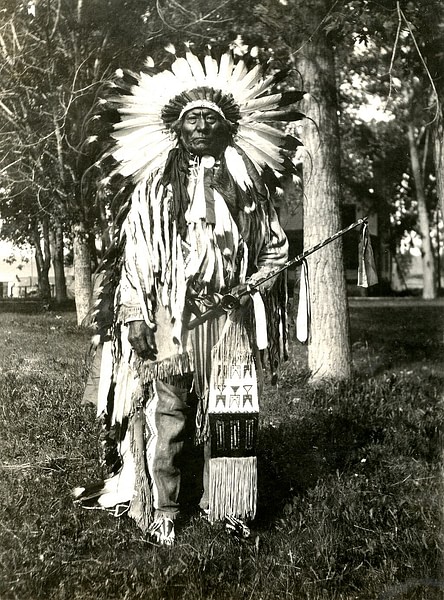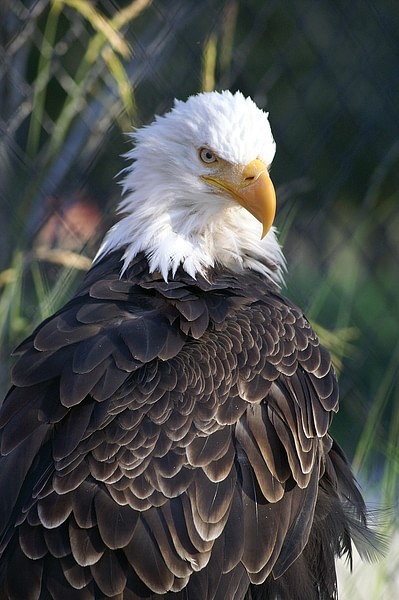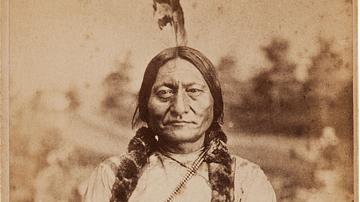
White Bull (Tatanka Ska, l. 1849-1947) was a Hunkpapa Lakota Sioux warrior, nephew of Sitting Bull (l. c. 1837-1890), who is among the many claimed to have killed Lt. Colonel George Armstrong Custer (l. 1839-1876) at the Battle of the Little Bighorn. He may also be the main character in the well-known Cheyenne tale An Eagle's Teaching.
White Bull participated in several engagements with the US military, including the skirmish at Arrow Creek by the Yellowstone River (Elk River) in 1872 between Sitting Bull and Custer. White Bull is the primary source for the famous story of Sitting Bull's "smoking party" during that encounter at which he demonstrated his complete contempt for Custer and his men by calmly smoking his pipe with others, including White Bull, within range of Custer's men as bullets whizzed and thumped into the earth around them.
He also fought in Red Cloud's War (1866-1868) alongside Sitting Bull, Crazy Horse, Red Cloud, Spotted Tail, Two Strike, Roman Nose (Cheyenne Warrior), Cheyenne chiefs Morning Star (Dull Knife) and Little Wolf (also known as Little Coyote), among others, including the Cheyenne warrior Wooden Leg who is another contender for the title of the person who killed Custer at the Battle of the Little Bighorn, the most famous engagement of the Great Sioux War of 1876-1877.
After the Battle of the Little Bighorn, White Bull followed his uncle and others, including Sioux war chief Gall (l. c. 1840-1894) into exile in Canada. He eventually returned, earlier than the others, and surrendered to US authorities. He later became a judge and an advocate for the claims of the Sioux concerning the Black Hills. Like Two Strike (l. c. 1831-1915), White Bull's participation in the resistance to US westward expansion has been overshadowed by narratives of his more famous contemporaries.
He is best known today for his contributions to Stanley Vestal's Sitting Bull, Champion of the Sioux (1932), a biography of his uncle, and for Lakota Warrior (or The Warrior Who Killed Custer), his autobiography (1998) edited by James H. Howard. The activist Floris White Bull (Floris Ptesan Hunka), presently engaged in protests against abuses of Native Americans by the US government, is his direct descendant.
Early Life & War
White Bull was the son of Hunkpapa Sioux Good Feather (Sitting Bull's sister) and Miniconjou chief Makes-Room in the region of the Black Hills of modern-day South Dakota. His birth name was Bull-Standing-With-Cow, but, when he was 16, he "counted coup" on three enemy warriors (striking without killing them) and was given the name White Bull by his uncle Black Moon. He also took at least ten horses from the enemy during this engagement. The theft of horses from other nations (including the United States) counted toward one's status, wealth, and personal or communal power.
Little is known of White Bull's life prior to the 1860s as later writers tended to interview him mainly on his famous uncle. He fought with Crazy Horse (l. c. 1840-1877) at the Battle of the Hundred-in-the-Hands (Fetterman Massacre) on 21 December 1866 and was also present at the Wagon Box Fight (2 August 1867) during Red Cloud's War. After the Fort Laramie Treaty of 1868, White Bull continued his resistance to the genocidal policies of the US government through various raids and skirmishes but, among these, is best known for his account of Sitting Bull's "smoking party" at Arrow Creek in 1872.
The Smoking Party & Little Bighorn
The "smoking party" story comes from the engagement (sometimes defined as a 'battle' but more of a skirmish) with Custer's forces at Arrow Creek near the Yellowstone River in 1872. The Sioux were engaged in a military campaign against the Crow nation when they were encountered by Custer's forces. Sitting Bull, and the other chiefs, retired to confer and decide on which enemy to attack, but this decision was made for them when several young warriors, including White Bull, raided the US military encampment and drove off their horses. Custer's forces then responded with gunfire and the fight began. Scholar Robert M. Utley describes the "smoking party" as given by White Bull:
As the sun rose on the battlefield, all eyes turned in wonder on Sitting Bull as he staged a spectacle of bravery so imaginative that it surpassed all others that day. After getting his pipe and tobacco pouch from his horse, he walked from the bluffs out into the open valley to within view of the soldier lines. He wore a shirt, leggings, and two feathers in his hair, and he also carried his bow, quiver of arrows, and a rifle.
Seating himself on the ground, he shouted, "Who other Indians wish to smoke with me, come."
As Sitting Bull calmly, and with studied deliberation, filled the bowl with tobacco, White Bull, Gets-the-Best-Of, and two Cheyenne ventured into the open and seated themselves beside the chief.
The "smoking party," as White bull termed it, was a terrifying experience. After kindling the tobacco, Sitting Bull puffed placidly, then passed the pipe to his companions. With pounding hearts, each puffed vigorously and passed it quickly down the line. Throughout, Sitting Bull said nothing, just looked around and smoked quietly as soldier bullets kicked up dirt and sang through the air. When all the tobacco had burned, Sitting Bull picked up a stick and thoroughly cleaned the bowl, stowed the pipe in its pouch, rose to his feet, and slowly walked back to the admiring knots of fellow tribesmen. The other smokers ran back, Gets-the-Best-Of so hastily that he left his bow and arrows on the ground. As a further display of his own bravery, White Bull returned to retrieve the weapons. This ingenious exhibition, so captivating to a people who placed great emphasis on daring, added to Sitting Bull's long list of valorous feats…It was, White Bull remembered, "the bravest deed possible." (108-109)
Between 1872-1876, White Bull supported his uncle in his resistance to US military aggression and later became famous for his participation in the Great Sioux War and, especially, the Battle of the Rosebud (17 June 1876) and the Battle of the Little Bighorn (Battle of the Greasy Grass, 25-26 June 1876). According to some claims, White Bull killed Lt. Colonel George Armstrong Custer at Little Bighorn with Custer's own weapon, but this claim has been challenged as others have also been cited as Custer's killer, including Sioux warrior Rain-in-the-Face (l. c. 1835-1905), the Cheyenne warrior Buffalo Calf Road Woman (l. c. 1844-1879) and others. White Bull, himself, claims he "struggled" with Custer but did not kill him.

After the Battle of the Little Bighorn, US military reprisals were swift, and the Cheyenne and Sioux parties divided under separate chiefs and went their own ways. White Bull followed Sitting Bull into the region of modern-day Canada but returned to the USA and surrendered later that same year. When his father died, White Bull assumed his position as a Miniconjou chief and settled his people at the Cheyenne River Agency reservation in modern-day South Dakota. As part of his efforts at assimilation with Euro-Americans, he took the name Joseph White Bull and served as a judge for the Court of Indian Offenses while also advocating for Sioux rights concerning the Black Hills.
An Eagle's Teaching
It is possible, though by no means certain, that the Cheyenne tale, An Eagle's Teaching, is about White Bull's early vision quest and explains why he was never seriously injured in battle, why he adorned his horse with the eagle feather, and how he was able to live to such an advanced age of almost 100 years. The interpretation of the tale as relating a young man's vision quest is suggested by the talking eagle, how the eagle leads him away to a separate space, and the line, "I stayed there all that day and all that night, talking with the eagle, and during all this time I had no water" (133) as one refrained from eating or drinking during a vision quest and one's visions frequently included talking animals, one's spirit animal or one's totem.
The story could be about the Cheyenne mystic and medicine man known as Ice (also known as White Bull, l. c. 1835-1910) who performed the miracle that convinced the Cheyenne that their god, Maheo, was still with them or, it could have to do with the Cheyenne warrior White Bull (also known as Phillip Cook, l. 1869-1929/1939) who also fought at the Battle of the Little Bighorn. It is likely, however, that the story – told in the first person by someone the eagle claims will be known as White Bull – is about the Lakota warrior White Bull, as he and his band were closely associated with the Cheyenne (to whom the work is attributed), and many details of the tale resonate with known facts of White Bull's life.
In addition to those mentioned above, these details include White Bull's close relationship with his brother, One Bull, his tendency toward thinking before acting, and his association with the eagle – though this last point, as with the adornment of his horse, could apply as easily to many Sioux or Cheyenne warriors.
The following passage comes from By Cheyenne Campfires by George Bird Grinnell:
It was a long time ago. I was a young man, and the people were camped on the south side of the Platte River. My brother went out hunting and killed a buffalo and an elk and broke the leg of another elk. He took all the meat of the elk, but only part of that of the bull.
That night, my brother said to me, "Come out with me tomorrow; you can trail up the elk that I wounded and can take part of the bull and make an eagle trap with it."
We started at daylight and, at last, came to a hill and, down below, we could see ravens flying and my brother said to me: "I killed the bull down there where you see those ravens." When we had almost reached the place, my brother said, "Go over and see what is there, but go carefully, for there may be a bear feeding there, or perhaps an eagle. If an eagle is there, wait, and perhaps it will eat so much that it will not be able to fly." When my brother had said this to me, he went on further.
I rode carefully up to where the buffalo was lying and peeped over the hill and, there, perched on the carcass, was an eagle feeding on the meat. I drew back and waited a long time, peeping over the hill now and then to see the eagle still there, feeding. Presently, I looked over the hill and saw the eagle sitting with its head up, and I thought that perhaps it had eaten all it wished to, so I crept about a ridge and came quite close to it.
At first, I was going to shoot it with my arrow, but just then it flew a little way very heavily and I saw that it could not go far. Therefore, I dropped on the prairie everything that I carried, except my bow and arrows, and ran after it. Again, it flew a little way and then dropped down on the ground and flapped its wings. It had eaten so much that it could go no further.
It lay there on its breast with its wings outstretched, and I was just about to send an arrow through its body, when the eagle spoke to me, saying, "Hold on, friend, wait; do not shoot."
When the eagle spoke, I was astonished and stopped and unstrung my bow. Then the eagle spoke again and said, "Look at this," and I saw, in the eagle's back, a hole with blood oozing out of it. The eagle said to me, "If you do not hurt me, you shall be able to cure all wounds like this one that you see."
Then I said to myself, "I will keep this bird and will ask him some more questions" and so I tied my bowstring about his wing and led him over to where my blanket was. This was a young, speckled-tailed eagle.
After we had come to where the blanket was, we talked for a time. The eagle said to me: "You see my wings and tail are speckled; your horse shall be so too. You shall be named from the animal that has been killed here; you shall be called White Bull, and everybody will know you by that name. Now I should like to have you let me go and, before I go, I will give you some of my power. You shall be great in fights. The bullets shall not hit you."
"No," said I. "I do not wish that."
"Well, said the eagle, "When you are on the warpath, you shall always know where your enemies are."
"No," said I. "I do not wish that."
I did not intend to let the eagle go easily.
The eagle said to me: "There are a great many people who are making many guns; perhaps, if you fight with them, you may pull through without being hurt." Some years afterward, I did have a long, hard fight with the white people, but they did not kill me.
At last, the eagle said to me: "Friend, you will live to be quite an old man and you shall never be poor or in want. Now, if you are ever wounded in the head or in the body, you must sing a certain song, one song for the head and a different one for the body." He taught me to sing those songs and how to cure myself and other people.
I stayed there all that day and all that night, talking with the eagle and, during all this time, I had no water.
Meantime, the camp had seen a war party of enemies and the people thought that I must have been killed. Men sent out to look for me went back to the bull, and reached the place before day, but did not find me. When day came, they saw me far off in a flat, and rushed toward me. When I saw them coming, I said to the eagle, "Friend, enemies are rushing on us."
"No," said the eagle. "Those are your own people."
Before the people reached me, I set the eagle free. It rose to go away but, before doing so, it flew about my head and said "That is the way people will charge upon you, and you will charge upon people. But, when you are in fights, you must always imitate my cry. Also, when you go into battle, you shall tie one of the middle tail feathers of an eagle in the tail of your horse and tie a horn of an antelope about his neck, for an antelope is a fast-running animal and long-winded, and your horse shall be long-winded too." Then he said to me, "Friend, now I am going, but remember that you shall have a long life."
Since that time, when in fights, I have always imitated the eagle.
Conclusion
Assuming the story is about White Bull of the Lakota, the eagle's prophecy came true, as he was only wounded once – in the ankle at the Battle of the Little Bighorn – even though he fought in many engagements and was often at the front of his band of warriors. At the Battle of the Rosebud, for example, he faced off against a Shoshone scout allied with General Crook's forces; the scout's shot missed White Bull at close range, but White Bull was able to unhorse the Shoshone warrior and count coup on him before riding on into the battle.
The eagle's prophecy regarding White Bull's longevity and status would also prove true as he lived to 98 years of age, dying of natural causes on the reservation as a highly respected chief with a large family. His descendants carried on his legacy of advocating for Sioux rights and continue to do so in the present day, as evidenced by the activism of the writer and filmmaker Floris White Bull, best known for her protests against the Dakota Access Pipeline in 2016 and her documentary Awake: A Dream from Standing Rock (2017). Unfortunately, White Bull's descendants – and Native American nations generally – face the same challenges posed by the policies of the US government and commercial interests today as he did; but, like him, continue to fight for their rights, their traditions, and their lands.






